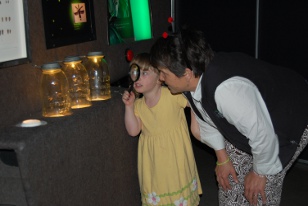Glow: Living Lights
PHILADELPHIA,
May 10, 2013
 Getting a close-up look at firefly jars. Visit our Press Room for more images.
Getting a close-up look at firefly jars. Visit our Press Room for more images. A living organism’s ability to produce its own light is one of the most fascinating, yet least understood, phenomena in nature. A new exhibit opening Saturday, June 1, at the Academy of Natural Sciences of Drexel University promises to shed light on this intriguing subject in a fun, family-friendly way.
Glow: Living Lights takes visitors on a journey through land and sea in pursuit of fascinating creatures that light up the dark through a mysterious chemical process called bioluminescence. Along the way, visitors can get up close to live scorpions, find themselves caught in a jar like a firefly, and youngsters can don creature costumes for pretend play.
Glow: Living Lights is on view through Sept. 29 and is free with regular museum admission.
Fireflies, glow worms, viper fish, and cookie-cutter sharks are just some of the creatures that produce light for communicating, camouflage, attracting prey, and for other reasons scientists still don’t understand. The 2009 movie Avatar helped bring the beauty of bioluminescence to the forefront.
Around Philadelphia, bioluminescence is demonstrated each summer as various species of fireflies put on their shows in yards, ball fields and forest edges, said Dr. Jon Gelhaus, Academy curator of entomology and a Drexel University professor. “I totally enjoy witnessing these wonderful fireflies with their greenish and yellowish flashes. We want visitors to Glow feel that sense of awe and excitement themselves.”
The journey begins
Visitors to Glow: Living Lights begin their journey in a darkened gallery filled with rare photographs, film footage of bioluminescent creatures, preserved specimens and engaging activities. As visitors move along, they’ll come to understand that bioluminescence is a chemical process that differs from other forms of light, such as fluorescence. Visitors can:
- Get up close to live emperor scorpions and desert hairy scorpions that glow under ultraviolet light.
- Press a button to illuminate live dinoflagellates (single-celled organisms).
- Meet an enormous anglerfish.
- Don firefly and sea creature costumes and pretend to be their favorite glowing animals.
- Discover how “glow” works using glow sticks.
- Get inside a walk-in firefly jar.
- See models and real preserved bioluminescent animals
- Learn how researchers are using natural light-producing abilities to detect harmful bacteria and even the presence of deadly anthrax spores.
Opening weekend activities include glow-in-the-dark craft-making and activities and specimen displays about animals that find different ways to survive in the dark.
Science research shows that about 90 percent of deep-sea creatures use bioluminescence, and today new applications of this quality are being made in chemistry, genetics, ecology and medicine. Earlier this year a team of sea explorers made headlines when they were able to capture video of a rarely seen giant squid using lures that mimic a favorite food—bioluminescent jellyfish.
Glow: Living Lights is produced by Exhibit IQ and supported by Aqua America, Inc.
Media Contact